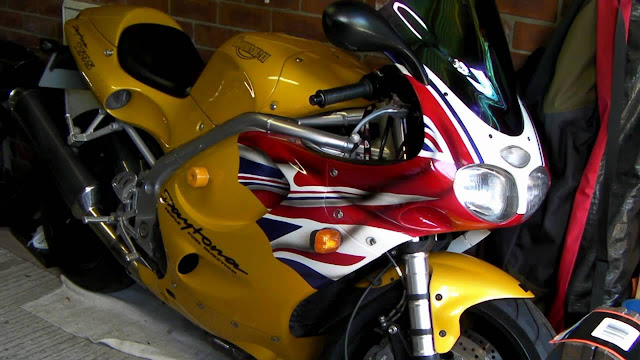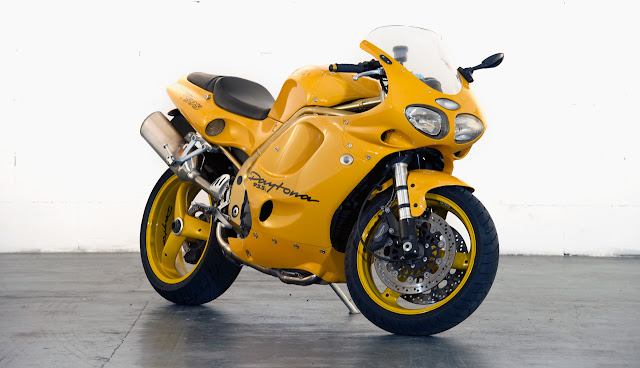Triumph T595 Daytona
The Daytona's aggressive styling, dominated by its sleek twinheadlampfairing. hinted at the 955cc triple's performance. Although the Triumph was not quite as racy as the most singleminded of its rivals, the British firm had finally produced a purpose-built sports machine that could trade punches with the best in the world.
The T595 Daytona was the bike with which Triumph came of age as a superbike manufacturer. Fast and fine- handling. the Daytona was the first sports bike from the reborn British firm that was designed to compete head-on with the best from Italy and Japan. And although the Triumph was slightly less racy than some super-sports rivals, its unique blend of style, performance and three-cylinder character made it a big success.
A crucial factor in the Daytona's development was Triumph boss John Bloor's decision to abandon the modular format with which his firm had entered the market in 1991. Modular design involved several different models sharing many components, and had proved a cost-effective way of developing a range of bikes rapidly. But it involved too many compromises for a competitive super-sports machine.
The Daytona changed all that. This time. Triumph’s designers had no such handicap in developing a purpose-built triple. The T595 title came from Triumph's factory codename, a factory tradition dating back to the T120 Bonneville and beyond, but the bike was later renamed the Daytona 955i because many people thought the 595 referred to capacity. This was in fact 955cc, as the motor was a bored-out version of the previous Daytona’s 885cc liquid-cooled, dohe 12-valve unit.
Inside the motor, new semi-forged pistons held thinner, low-friction rings and moved in new aluminium liners. Lotus Engineering helped tune the motor by improving its breathing with larger valves, new cams and lightened crankshaft. Magnesium engine covers, modified crankcases and a redesigned gearbox and clutch further reduced weight. Other engine-related changes included a new airbox. three-into-one exhaust system and Sagem fuel-injection system.
If the motor was a development of its predecessor, then the chassis of which it formed a stressed member was totally new. In place of the old steel spine was a perimeter frame of twin oval- section aluminium tubes. Styling was a key factor in the chassis design, hence the frame’s polished tubes and the single-sided swingarm that enhanced the Daytona’s sleek and distinctive look.
Suspension w;as by Showa of Japan, with 45mm forks and a similarly multi-adjustable shock.
From the rider’s seat the Daytona felt notably more compact than previous Triumphs, and it was certainly much faster too. The new motor was smooth and eager to rev. It kicked hard anywhere above 6000rpm to send the triple surging forward and its rev-counter needle flicking towards the I0.500rpm redline. Peak output was I28bhp at I0,200rpm, giving a I5bhp advantage over the previous Daytona Super III. With its rider tucked down behind the fairly low screen the triple was good for over I60mph (257km/h). Only the slightly notchy six-speed gearbox and a noticeable power dip at about 5500rpm marred the impression of a superbly fast and sophisticated sportster.
There were no such complaints about the handling, particularly on the road where the Triumph’s combination of light, neutral steering and confidence-inspiring stability was very impressive. The top-heaviness of previous Triumphs was gone, replaced by a pleasantly manageable feel, and backed-up by excellent control from the firm yet compliant suspension Although the Daytona could not quite match the agility of its raciest rivals, it was not far behind, and its Nissin brake system gave outstanding stopping power.
The T595 Daytona was more than an excellent sports bike, it was proof that Triumph was trul\ back in the big time. Almost 30 years after Honda-' CB750 had arrived to outclass the previous Meriden-based factory’s T150 Trident triple and".a'ten the demise of the once dominant British t> 'cycle industry. Triumph once again had a 'P rr.ng ' jperbike that stood comparison with the \erx be't in the world.
The Daytona’s look was enhanced by its frame, made from oval-section aluminium tubes.
Specification Triumph T595 Daytona (1997)
- Engine Liquid-cooled dohc 12-valve triple
- Capacity 955cc (79 x 65mm)
- Maximum power 128bhp @ 10,200rpm
- Transmission Six-speed, chain final drive
- Frame Tubular aluminium perimeter
- Suspension Telescopic front; single shock rear
- Brakes Twin discs front; disc rear
- Weight 436lb (198kg)
- Top speed 165mph (266km/h)





















0 comments: